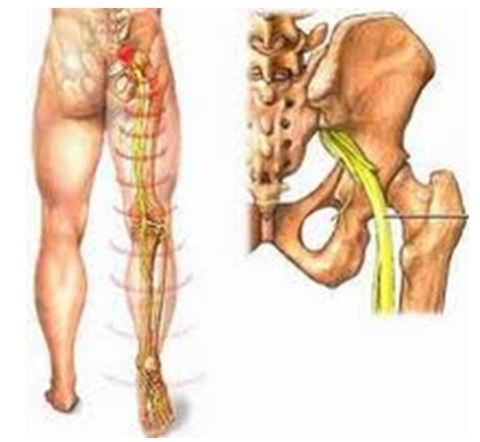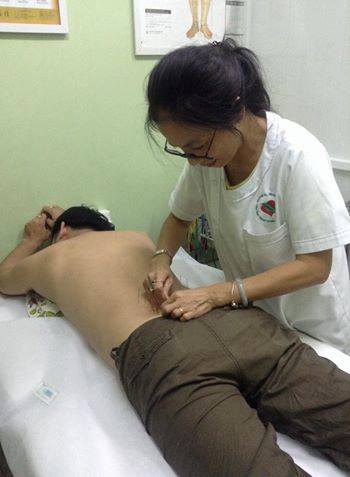Most cases of sciatica are not sciatica at all but are Piriformis Syndrome! The piriformis is a muscle that connects from the lumbar spine, passes through the sacrum to the hip bone (greater trochanter). In Piriformis Syndrome the muscle becomes tight and contracts around the sciatic nerve producing pain.

Sciatica or more accurately lumbar radiculopathy is the name given to a condition that involves the root of the nerves being impinged or inflamed causing pain, numbness or paraesthesia. It usually has its origin in the lower back where the lumbar and sacral spinal nerves are located. Pain from this condition is usually referred down one or both legs with symptoms that include pain and/or tingling radiating down the buttock, back of one leg to the foot.
Patients suffering from sciatica may also experience patchy numbness of the skin in the region affected by the pain, and weakness of some of the muscles of the lower leg. The pain is typically aggravated by movements which affect the low back, particularly bending forward and to the side. From the western medical point of view, sciatica results from damage to one or more of the lumbar or sacral spinal nerves emerging from the very base of the spinal cord. Damage to these nerves can arise from anything which compresses them, as they descend through the spinal canal, or as they emerge through the intervertebral spaces.
The most likely cause of compression of the spinal nerves is the protrusion (“prolapse”) of an intervertebral disc, either between the L5/S1 vertebrae, or between the S1/S2 vertebrae causing compression of the nerve roots.
This diagram shows how the bulging of the posterior part of an intervertebral disc can affect either the spinal nerves (b) or the cord itself (a), depending upon the site of the bulge. The bulging which is slightly to one side (b) is by far the most common scenario.
The other common cause of compression of the spinal nerves is osteoarthritis or degeneration (wear and tear) of the vertebrae. This degeneration can lead to narrowing of the intervertebral spaces as well as the spinal canal itself, causing the disc to prolapse. Western Medicine may use the term lumbar spondylosis to describe the degenerative causes of sciatica and low back pain.
Sciatica may also occur as a result of tension in the muscles and ligaments which support the vertebrae. Tension causes the vertebrae to be squeezed close together and cramps the spaces through which the spinal nerves should exit. This form of sciatica is typically less severe and tends to appear and disappear with according to factors such as overwork, tiredness, moods and the weather.
Sciatica – Diagnosis in Western Medicine
A Doctor may diagnose arthritic changes of lumbar spondylosis by taking an X-ray of the spine, however it is well accepted that since x-rays are used mainly to look at the bones there is a poor correlation between the changes seen on an X-ray and severity of symptoms. The best, most informative method for diagnosing this kind of problem is using an MRI scan, which will usually show what is happening with the soft tissues and therefore the site of the compression of the spinal nerve, and whether or not a disc prolapse is present.
Sciatica – Diagnosis in Chinese Medicine
In Chinese medicine pain is considered to be energy of Qi that is stuck and not moving. Numbness is due to Damp (ask me about this in the clinic) and if the condition is made better with warmth, it may indicate that there is Cold present – this may also be felt as the tissues being cold or adhesions (knots) within the local muscles as feeling hard and close to the bone. In some cases where the condition is relieved in cooler weather Damp-Heat may be present. The acupuncture channels of the Gallbladder and Bladder channels are usually indicated. The degeneration associated with osteoarthritis is an indication of an underlying deficiency of the Kidneys energy and is very often the reason why sciatica has developed.


Sciatica Treatment using Acupuncture
Pain that manifests as stuck Qi & Blood in the muscles is treated by using acupuncture to move Blood and Qi through the affected area. If there is a background condition of Damp-Heat or Damp-Cold we will use acupuncture needles and cupping to clear those conditions. Several acupuncture points will be manipulated using cupping and needling to clear stuck energy in the Gall Bladder and Bladder Channels to relieve pain. If osteoarthritis is indicated, the Kidney energy will be strengthened to slow down the degenerative process.